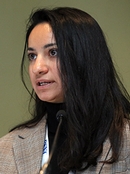From single section CT scanners to multidetector systems capable of covering the entire heart in a single rotation, CT has experienced a dramatic evolution over the past several decades. As a result, it is now a mainstay of diagnosis in many pathologies–including complex and small anatomical structures.

Mesropyan
“Dedicated non-enhanced maxillofacial CT and temporal bone CT are the current reference standard for assessing paranasal sinuses and temporal bone anatomy and pathology,” said Narine Mesropyan, MD, a medical doctor and scientific associate in the Clinic for Diagnostic and Interventional Radiology at the University of Bonn, Germany. “It is also the primary diagnostic tool for procedural planning.”
Despite these advancements, Dr. Mesropyan stressed how it is critical that radiologists continue to optimize scanning protocols, especially in terms of radiation dose reduction, while also maintaining high and sufficient image quality using state-of-the-art imaging techniques and technologies such as photon-counting CT.
An Emerging Technology
Photon-counting detector (PCD)–based CT is an emerging technology that uses new energy-resolving X-ray detectors with mechanisms that differ from those of conventional energy-integrating detector (EID)-based CT systems. PCD CT can count single X-ray photons and discriminate them according to their energy. As a result, this technique allows for improved signal- and contrast-to-noise ratio, increased spatial resolution and reduced radiation exposure.
This capability to provide CT data at high spatial resolution and with inherent spectral information makes photon-counting CT particularly attractive for the imaging of complex and small–even miniature–anatomical structures.
“High spatial resolution is necessary for the sufficient imaging of paranasal sinuses and temporal bone, which typically requires a high radiation dose exposure,” Dr. Mesropyan explained during a Sunday session.
Being able to reduce radiation exposure is critical due to the proximity of radiosensitive organs in scan volume (e.g., eye lenses), in pediatric populations, young adults, and in patients undergoing repetitive examinations.
“This is why further optimizing scan protocols, as well as developing and implementing new CT techniques, are of great clinical importance,” Dr. Mesropyan added.
A Drastic Reduction of Radiation Dose
To support this optimization, Dr. Mesropyan recently led an experimental study that investigated the potential of new clinically implemented photon-counting CT for paranasal sinuses and temporal bone imaging.
The study used different radiation dose settings in comparison to other state-of-the-art CT systems, including dual-layer spectral and dual-energy dual-source CT. Different qualitative and quantitative parameters of image quality and radiation dose exposure using different scan settings were also evaluated and compared.
The study demonstrated that a photon-counting CT system allows for a drastic reduction in radiation dose while maintaining good and, for clinical use, sufficient image quality up to ultra-low-dose settings, which was also superior to other evaluated CT systems.
According to Dr. Mesropyan, these findings open the door to new possibilities in CT imaging.
“To fully leverage the potential of CT imaging, it is essential that radiologists and clinicians grasp the principles of recent and upcoming advances, especially with novel techniques such as photon-counting CT on the horizon,” she concluded. “This technique in particular may overcome the limitations of commercially available EID-based CT, allowing us to reduce radiation exposure while maintaining the high image quality that made CT a mainstay in many pathologies in the first place.”
Access the presentation, “Image Quality and Radiation Dose of Photon Counting Temporal Bone and Paranasal Sinuses CT -A Comparison With Dual Source and Dual Layer CT,” (S1-SSHN01-2) on demand at Meeting.RSNA.org.
Does your radiology department offer photon-counting CT? #RSNA22
— RSNA (@RSNA) November 27, 2022

